My friend Ivan goes over the the Q Collar by Q30 which is a collar worn to protect against Traumatic Brain Injury.
To read the entire article, visit kitbadger.com/the-q-collar-by-q30.
My friend Ivan goes over the the Q Collar by Q30 which is a collar worn to protect against Traumatic Brain Injury.
To read the entire article, visit kitbadger.com/the-q-collar-by-q30.
JOINT BASE SAN ANTONIO-FORT SAM HOUSTON, Texas (AFNS) —
Army and Air Force personnel from Brooke Army Medical Center’s Department of Emergency Medicine recently established a simulation training platform to increase readiness and meet Joint Commission requirements for staff development and training.
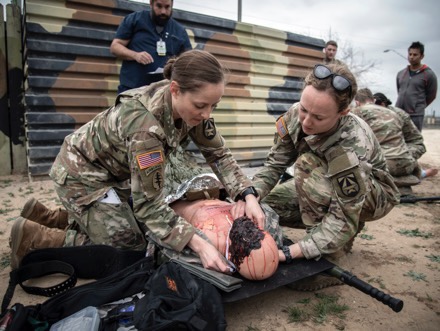
The Tactical Trauma Reaction and Evacuation Crossover Course, or TTREX, is designed to test and validate Individual Critical Task Lists and the Comprehensive Medical Readiness Program for military medical personnel.
“The TTREX course was developed to familiarize military and civilian personnel with critical trauma skills relevant to both the hospital and the austere environment and to maintain mission readiness,” said Army 1st Lt. Jackson Goddard, registered nurse.
The eight-hour course at the Torch Training Site at Joint Base San Antonio-Lackland incorporates battlefield trauma simulations, evacuation procedures, and trauma care in a Role 2 environment. Role 2, also known as forward resuscitative care, has the capability to manage more advanced trauma patients and continue more advanced resuscitative measures in an austere environment such as a combat support hospital.
“We have combined the point of injury with the Role 2 environment,” said Air Force 1st Lt. Marissa Vasek, registered nurse. “Our goal is to get people to understand the deployment setting and the challenges they might face while deployed including limitations with supplies, manpower or experience.”
Additionally, participants experience what it’s like to be on a C-130 Hercules military transport aircraft during a critical care air transport mission to see how a patient is transported to a higher echelon of care.
Army Spc. Wade Wolf, a combat medic, said he feels the training is beneficial because participants get to see how a patient moves from the point of injury to a stateside hospital.
“We’ve had more than 40 participants over the two-day exercise,” Wolf said. “I would say about half of them have never been deployed.”
Emergency nurse Army Capt. Megan Gross agreed.
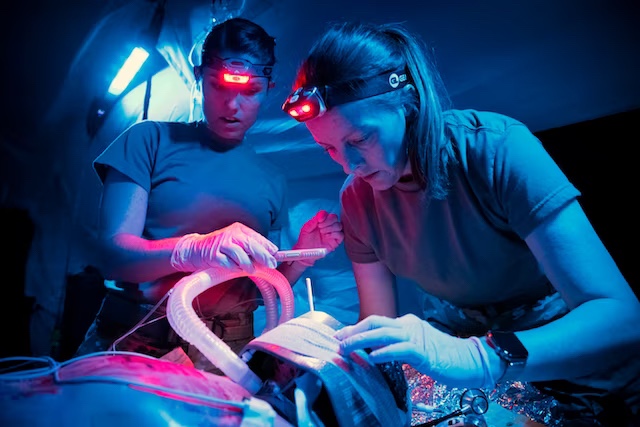
“This has been one of my favorite courses I have attended in my 14 years in the military,” Gross said. “The course allows nurses and medics to test their trauma knowledge in a tactical environment and provides a realistic peek into the deployed setting. The teamwork and camaraderie among the attendees and the instructors are unique and foster a real esprit de corps.
“My favorite part was the Role 2 trauma lane and having the opportunity to work in a small team to assess, perform interventions, and prepare our patient for transport,” she added. “The autonomy aspect provided a unique learning opportunity we often do not get in the hospital setting. The instructors provided a learning environment that was challenging but collaborative at the same time. I loved it!”
The TTREX course will be offered quarterly and is open to service members, civilians, and contractors.
“The course is geared to medics and nurses, but it’s open to anyone who’s willing to learn or just wants to observe,” Vasek said. “We have even had a few physicians come through.”
“A part of creating this exercise was to help military nurses and medics gain the confidence they need to perform under high stress while downrange,” added Army Capt. Brianna Barkley, a registered nurse who helped create the course. “We have seen camaraderie built amongst BAMC teammates while also checking off required readiness skills. What made our exercise successful is the fact that it is a learning environment. Participants feel comfortable making mistakes and learning from those mistakes to build confidence during deployments.”
“This training is invaluable because it allows service members to maintain combat readiness,” Gross said. “We have Individual Critical Task Lists, which are required training tasks for our jobs. This training opportunity allowed me to complete all of my ICTLS for the year, which maintains my individual combat readiness.”
“I was so impressed with this course as a participant that I volunteered to become an instructor and look forward to being a part of the next TTREX course,” she added.
By Lori Newman, Brooke Army Medical Center Public Affairs
Army photos by Jason W. Edwards

WASHINGTON — The Command Sgt. Maj. Jack Clark Army Best Medic Competition is a grueling three-day test of strength, knowledge and endurance held annually. This year’s competition at Fort Polk, Louisiana, put some of the best medics in the Army to the test by challenging their abilities to determine who is the most skilled.
This year’s winners, Capt. Alexander Kenney and Sgt. 1st Class Douglas Petty from the 6th Ranger Training Battalion, Airborne Ranger Training Brigade, demonstrated exceptional skill, resilience and teamwork, solidifying their place among the top medics in the Army.
Combat medic specialists — also known by their military occupation specialty 68W — play a critical role in the Army. They are responsible for providing medical support to Soldiers on the battlefield and ensuring their health and well-being. They are often the first line of aid and care when Soldiers are injured or become ill.
Medics are required to be physically fit, mentally tough and knowledgeable in a wide range of medical procedures and techniques. The Army’s Best Medic Competition is not only a test of individual skill and endurance but also a testament to the importance of the medic’s role in the Army.
Kenney explained the competition is broken down into multiple phases: the Army Combat Fitness Test; an obstacle course; aircraft repelling; Combat Water Survival Test; a helocast; a ruck march; an extrication exercise; casualty hoist operations; M4 rifle qualifications; stress shoots; a written test; day and night land navigation; tactical combat casualty care; health services and support; prolonged field care; a mystery event; and a chemical, biological, radiological and nuclear event.
Kenney is a former combat medic and currently serves as the battalion physician assistant, or 65D, for the 6th Ranger Training Battalion. Petty, on the other hand, had no medical experience prior to joining the Army in 2009. Despite this, he chose to become a combat medic and worked hard to become an excellent one. Both Soldiers put in tremendous effort to achieve their status as top-tier medics.
Winning the Best Medic Competition requires more than just physical fitness and knowledge of medical procedures. It requires a relentless pursuit of excellence, a dedication to being the best possible version of oneself, and an unwavering commitment to the well-being of fellow Soldiers.
Kenney and Petty have put in years of hard work and training to reach the level of skill and knowledge necessary to be the best medics in the Army. They have been tested in some of the most challenging and demanding environments imaginable, including combat deployments to Iraq and Afghanistan, and have emerged stronger and more resilient as a result. Their journey to the top of their field has been a long and difficult one, but it has prepared them well for the challenges that lie ahead.
Kenney noted that “being prepared and pushing the limits of what you know at any given time was super important.”
This mentality of being a lifelong student is essential to being the best medic possible.
Petty agreed, saying that “It made me realize real quick that if I don’t stay on top of my medicine and my mental state, that not only am I going to feel the repercussions of it, but the guys are going to feel the repercussions of it as well.”
Both Soldiers are now dedicated to teaching the next generation of medics.
“One of the best things about military medicine, especially as [physician assistants], is most of us are prior enlisted,” said Kenney. “Not a lot of us are direct commissions off the street or non-medical people beforehand, and we understand the value of building that in the next generation.”
Petty, who now serves as the battalion senior medic and medic platoon sergeant, knows the importance of sharing his knowledge and experience.
“I want to be able to pass that knowledge on to them and see them want to do stuff and be able to help them with the connections I have to get to these other places,” he said. “Train them up to go to these places and go to schools that I have been to and that Capt. Kenney has been to, we have that knowledge to pass to them to see them be successful.”
Petty is also keenly aware of the weight of his responsibility at 6th Ranger Training Battalion.
“It’s the most dangerous, the most high-risk battalion in the United States Army,” he said. “Maintaining health and welfare is a huge portion of that, and understanding what each one is going through — which is why we’re all Ranger tabbed as well — we’ve all been through the program. So knowing what their issues are, and knowing what their struggles are, are super helpful in being able to deliver effective care and anticipate what their challenges are going to be medically.”
The Ranger Tab refers to a badge earned by Soldiers who have completed the grueling Army Ranger School, a course that specializes in small unit tactics and leadership. Rangers develop functional skills directly related to units whose mission is to engage the enemy in close combat and direct fire battles.
Kenney and Petty have done what few in the Army have. They have proven that they are the best of the best. But for them, it is not about the accolades, but about the work they do every day to make sure that their fellow Soldiers are healthy and well.
“Integrity and dedication. It’s a no-fail mission, so you have to be dedicated to what you do,” said Kenney. “And the integrity piece of it is not only doing the right thing 100% of the time, but having the self-check, self-awareness, the integrity to take it up every day. Learn something new and be better than you were yesterday, because medicine is a lifelong learning experience.”
Petty agreed, saying he’s “trying to instill in them the confidence and knowledge and a willingness to want to grow both medically and as a Soldier.”
Kenney and Petty serve as role models for anyone who wants to make a difference in the lives of others, and they exemplify the very best of what it means to serve in the U.S. Army.
“The greatest benefit that you can actually see is from the ground up,” said Kenney.
“I do enjoy the fact that I continually have to learn, and it’s not something I get bored with,” said Petty. “That willingness to never give up has really made me succeed throughout the Army.”
By SGT Pablo Saez, U.S. Army Public Affairs
HunterSeven Foundation shared this information on Heavy Metal Toxicity.
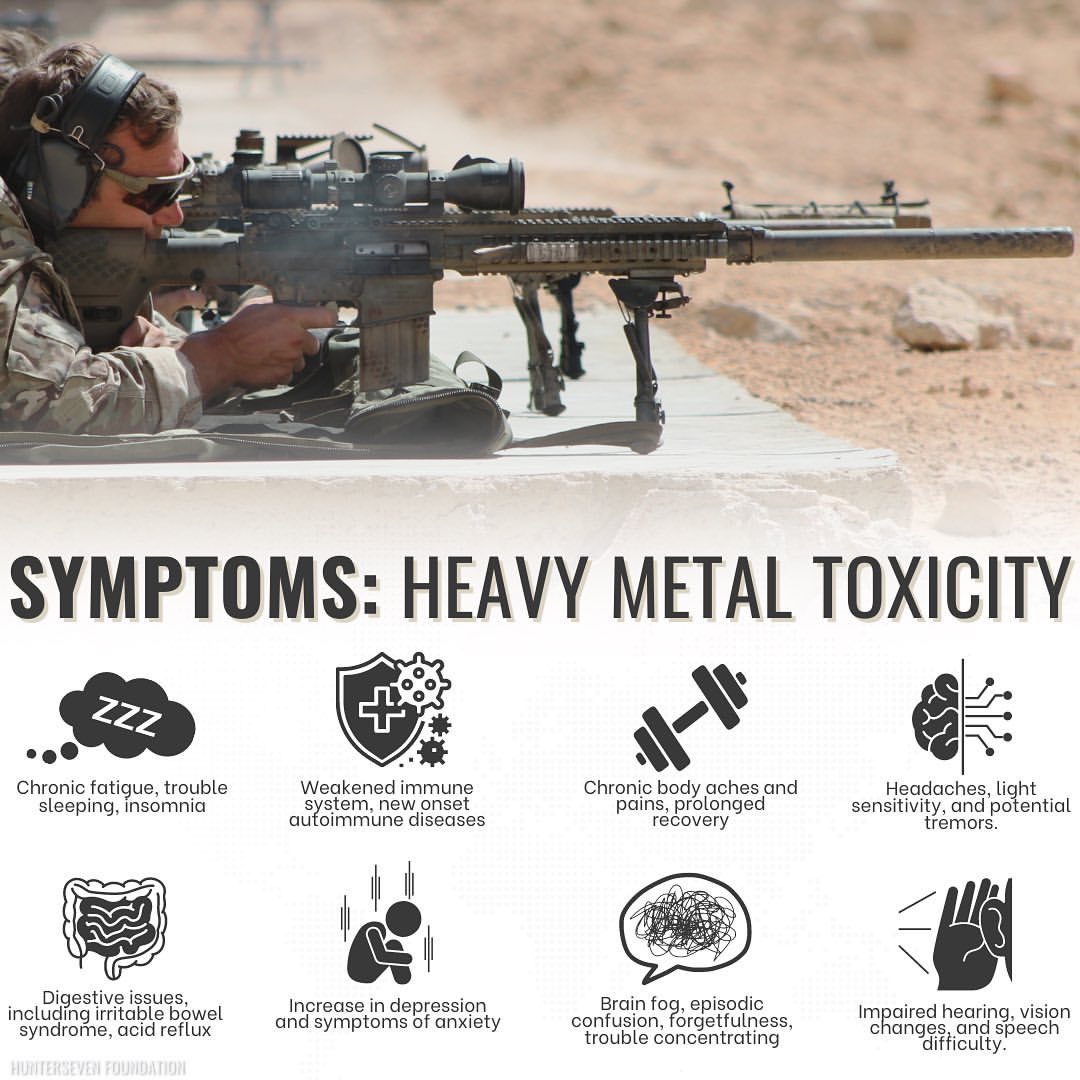
Heavy metal toxicity isn’t restricted to just Lead. Other metals like Cadmium, Mercury, Chromium, Aluminum, and Uranium are considered toxic at increased doses/exposures as well.
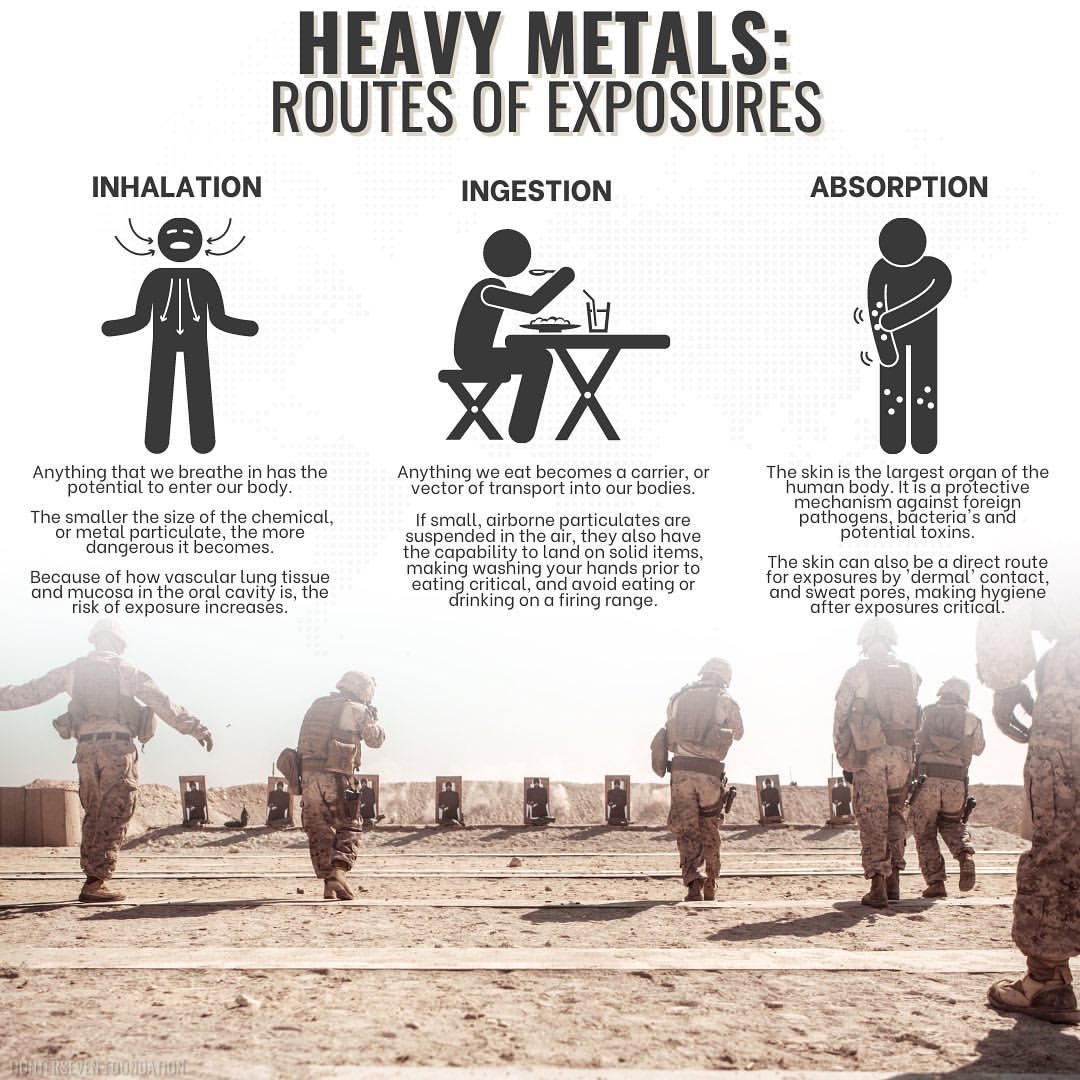
While short term exposures (<24hr.) may cause acute symptoms, such as headaches, nausea, dry throat, cough, and a slight fever, a majority (~75%) of these metals will be excreted. The other 25% circulate in the blood for a month or so before entering soft tissues and in the bone.
Once the heavy metals enter the soft tissue and bones, the ‘acute’ symptoms lessen, as the metals are not ‘active’ in circulation.
On the other hand, those repeat exposures continue the process stated above. Multiple exposures have the same ending.
Heavy metals, like Lead, remain in soft tissue for a few months, whereas it remains in bones for upwards of 25 to 30 years. Cadmium is approximately 38 years.
As those exposures continue, the deposits in the bone continue as well. Slowly increasing more chronic, systemic symptoms, including the ones mentioned on the graphic.
So the question is how can we prevent these chronic issues from occurring?
1. The obvious, do your best to prevent these exposures, meaning using special cleaning wipes, protecting your oral and nasal cavity, shooting outdoors when possible, changing your clothes, not eating / drinking on ranges, etc.
2. If you’ve been exposed for a LONG time, and you are symptomatic, there are specialized providers who can test, assess, and treat chronic heavy metals exposures through ‘chelation’ therapy.
Chelation is tough on the kidneys, so it is ordered and monitored closely by medical staff.
Otherwise, certain foods have been promoted as detoxifying agents, which may be helpful in that acute period (time of exposure -to- 2 months).
Germany’s Federal Office of Bundeswehr Equipment, Information Technology and In-Service Support (BAAINBw) has contracted with Rheinmetall for the conversion of modular medical equipment (MSE).

Worth a figure in the mid-single-digit million-euro range, the order will be complete by December 2023.
MSE containers comprise a family of modular ambulance facilities manufactured by Zeppelin Mobile Systeme. In the 1970s, various user states procured rescue station, rescue centre light, rescue centre and emergency hospital variants, which are now undergoing a comprehensive overhaul.
MSE rescue centres and field hospitals are used in Bundeswehr areas of operation. Individual systems are designed for special tasks such as the generation and supply of medical gases in the equipment supply container, or GVC. In deployed operations, the technical and medical equipment of the GVC supports the adjacent operating theatre. The container systems are CSC-classified, stackable and thus suitable for transport on container ships. The systems and their equipment are adapted in terms of scope and functionality.
Responsible for mobile deployable mission solutions, Rheinmetall Project Solutions GmbH has been pooling resources and capabilities for mission support since 2019. Rheinmetall AG created the company to handle services and projects for mission support. It provides customers with long-term mission support via specific services.
Dr. Deniz Akitürk, managing director of Rheinmetall Project Solutions GmbH, is proud of the new project: “Rheinmetall Project Solutions GmbH, in association with Rheinmetall Zeppelin Mobile Systeme, delivers comprehensive mission support. In addition to the construction and operation of forward operating bases, we also bundle protection and surveillance capabilities as well as medical expertise for our customers. As a system provider, we are pleased to be supporting the regeneration of medical equipment. In future, we could be modernizing a further 350 accommodation containers.”
The order underlines Rheinmetall’s high level of competence in mission support for the German Bundeswehr in the medical domain.
Noble’s multi-spectral shielding and antimicrobial technology supports modern era of warfare
SCRANTON, PA. (January 10, 2023) — Noble Biomaterials, creator of conductive energy textiles and advanced antimicrobial systems, announces today that its Noble Dfense™ technology is expanding into European countries as the war in Ukraine continues and combat troop demands become increasingly technical.
Noble Biomaterials has been a major supply partner to the United States military for over two decades. Noble’s Dfense™ technology has recently been adopted by government agencies in Israel, Asia, The United Kingdom, and now the product portfolio is expanding to Eastern European countries as the conflict in Ukraine continues.
“Noble Dfense™ has proven highly effective in mission-critical military and aerospace applications,” said Joel Furey, Founder and Chief Commercial Officer at Noble Biomaterials. “Noble Biomaterials has spent years developing multi-spectral energy management systems for security and protection. Whether the objective is to transfer energy, shield energy, or add antimicrobial technology, our portfolio of products embeds capabilities that provide a measurable combat advantage for U.S. forces and our allies.”
Noble Dfense™ products include fiber, fabric, and foam textiles used in soft or hard surfaces for fixed and mobile applications. Commercial products include apparel fabrics, tents, shelters, tapes, wallpapers, and medical devices. Noble Dfense™ was originally developed to permanently mitigate bacteria build-up. The silver technology quickly transitioned into solutions in EMI/RFI shielding, thermal and electrical conductivity, IR signature, biometric monitoring, and static control.
Noble Biomaterials is a registered FDA medical device facility, an essential sole-source technology supplier of medical components to the US military, and a US EPA–registered antimicrobial manufacturer. Noble products are EPA, FIFRA, BPR, and CE conforming.
The silver technology used in Noble Dfense™ provide a mechanical antimicrobial benefit that removes bacteria on fabric. The technology is permanent and never washes out of the fabric. Noble Dfense™ uses passive and active mitigation systems with the ability to counter directed energy attacks in fixed and mobile locations. The technology utilizes proprietary material technology that scatters and shields energy waves by reducing the power of the wave up to 100dB. This level of protection, deployable within soft and hard surface applications, is far above industry commercial standards and is currently utilized by the U.S. Department of Defense and Department of State.


Noble Dfense™Conductive Material from Noble Biomaterials
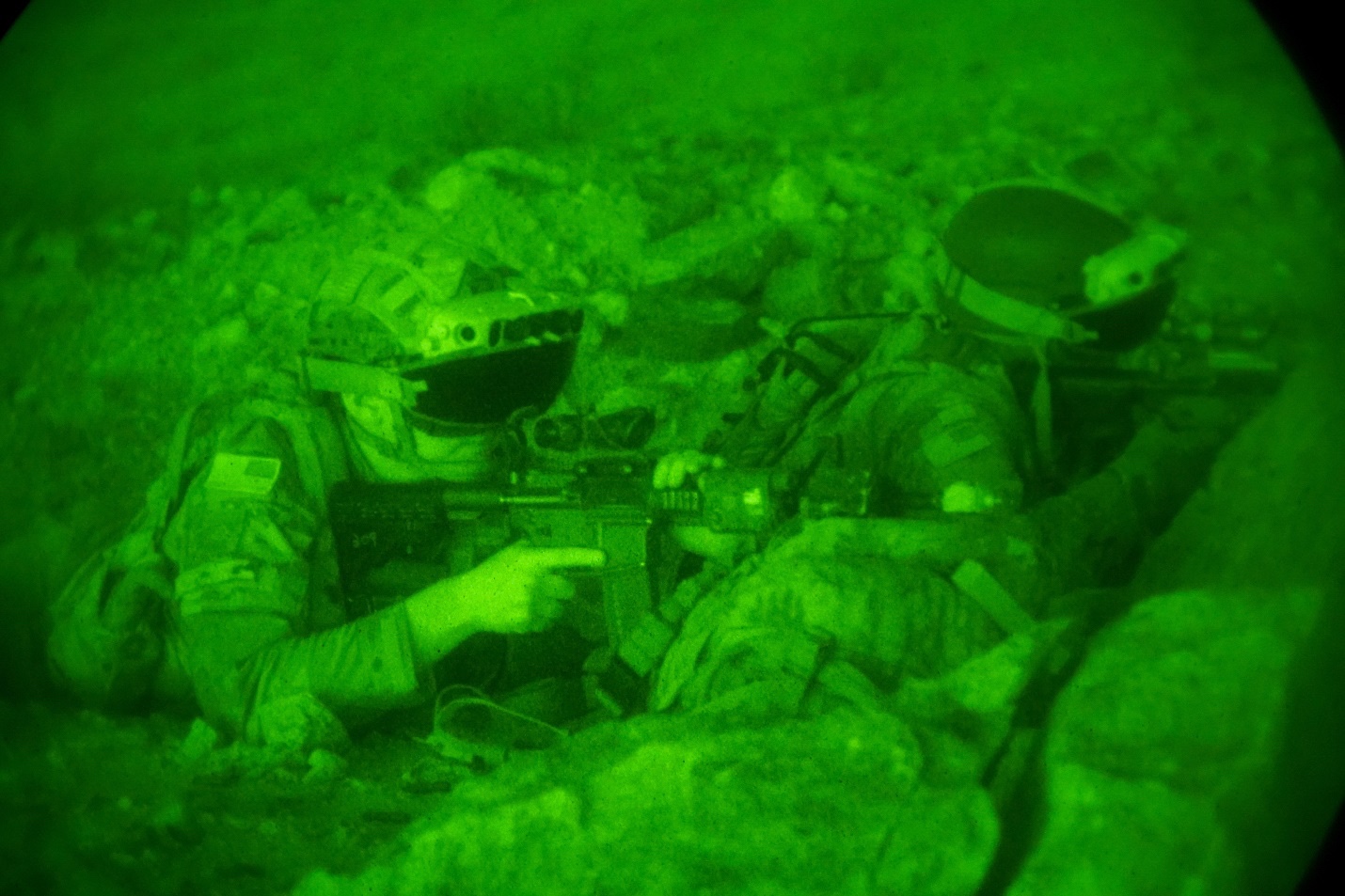

For more information on Noble Biomaterials and to view their full range of fabric applications, please visit www.noblebiomaterials.com.